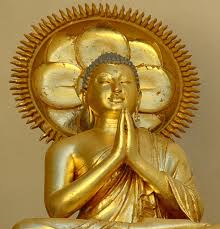Namaskara or Anjali Mudra
Namaskara or Anjali Mudra (Gesture of Praying / The Diamond Handclasp) The Anjali Mudra is the mudra of offering and devotion. It is formed by joining the hands, which are held vertically at the level of the breast, palm against palm, fingers against fingers, interlocked at the tips, the right thumb covering the left. The gesture formed by the union of the two hands, recalls the co-existence of the two inseparable worlds, which are really one: the Diamond World, or vajradhatu and the Matrix World, or gharbhadhatu. These two worlds are the expression of two aspects of one cosmic life and represent the reciprocal action of the spiritual and the materials, the static and the dynamic. As this mudra is a gesture of adoration, giving homage to a superior state, it is never represented on a statue of the Buddha. It is a gesture, which belongs rather to Bodhisattvas and to lesser personages who give homage either to the Buddha or to the dharma. It is frequently seen on multiple-armed Avalokiteshvara (Kannon or Kwan-Yin). Universally used by people in India and South-East Asia for salutation, it evokes an offering of good feelings, of one’s person, etc. and also indicates veneration if it is made at the level of the face.
